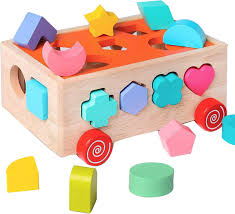Types of Early Learning Toys
2024-07-30
Early learning toys are designed to stimulate and support the development of young children, helping them acquire fundamental skills through play. These toys are crucial in the early stages of a child’s life as they can foster cognitive, physical, and emotional development. Here’s a look at different types of early learning toys and their benefits:
Types of Early Learning Toys:
1. Sensory Toys:
- Examples: Rattles, textured balls, sensory bins.
- Benefits: Stimulate the senses (touch, sight, sound) and help babies explore their environment. They can enhance sensory processing and motor skills.
2. Educational Toys:
- Examples: Alphabet blocks, counting toys, shape sorters.
- Benefits: Introduce basic concepts like letters, numbers, and shapes, supporting early literacy and numeracy skills.
3. Interactive Toys:
- Examples: Toys with buttons, levers, or interactive screens.
- Benefits: Encourage problem-solving and fine motor skills through hands-on interaction and cause-and-effect play.
4. Building and Construction Toys:
- Examples: LEGO blocks, wooden building sets, stacking rings.
- Benefits: Promote creativity, spatial awareness, and fine motor skills. They also support problem-solving and planning.
5. Pretend Play Toys:
- Examples: Play kitchens, doctor kits, tool sets.
- Benefits: Foster imagination, social skills, and language development through role-playing and storytelling.
6. Musical Toys:
- Examples: Toy drums, xylophones, musical mats.
- Benefits: Develop auditory skills, rhythm, and coordination. They can also be calming and fun.
7. Physical Activity Toys:
- Examples: Activity gyms, ride-on toys, crawl tunnels.
- Benefits: Promote gross motor skills, balance, and coordination through movement and physical play.
8. Puzzle Toys:
- Examples: Jigsaw puzzles, peg puzzles, shape-matching puzzles.
- Benefits: Enhance problem-solving skills, hand-eye coordination, and cognitive development.
9. Books:
- Examples: Board books, picture books, interactive books with flaps.
- Benefits: Support early literacy, language development, and bonding through reading.
10. Bath Toys:
- Examples: Floating animals, bath books, pouring cups.
- Benefits: Make bath time fun while promoting sensory exploration and fine motor skills.
Benefits of Early Learning Toys:
1. Cognitive Development:
- Skill Building: Toys that encourage problem-solving, critical thinking, and concept understanding lay the groundwork for future learning.
2. Motor Skill Development:
- Fine Motor Skills: Toys that require grasping, stacking, or manipulating help develop hand-eye coordination and dexterity.
- Gross Motor Skills: Toys that promote crawling, walking, or climbing support physical development and coordination.
3. Social and Emotional Development:
- Imagination: Pretend play toys foster creativity and help children understand social roles and relationships.
- Emotional Expression: Toys can provide a way for children to express their emotions and learn about empathy.
4. Language Development:
- Vocabulary Building: Interactive toys and books can introduce new words and phrases, supporting language acquisition and communication skills.
5. Bonding and Interaction:
- Parent-Child Interaction: Playing with toys provides opportunities for parents and caregivers to engage with children, enhancing bonding and communication.
Choosing the Right Toys:
1. Age Appropriateness:
- Ensure that the toys are suitable for the child’s developmental stage and do not pose choking hazards.
2. Safety:
- Look for toys made from non-toxic materials and free from small parts that could be a choking risk.
3. Educational Value:
- Choose toys that align with the child’s interests and developmental needs to keep them engaged and motivated to learn.
4. Durability:
- Select toys that are well-made and durable to withstand frequent use and play.
Early learning toys play a vital role in a child's development, offering opportunities for exploration, learning, and fun.



